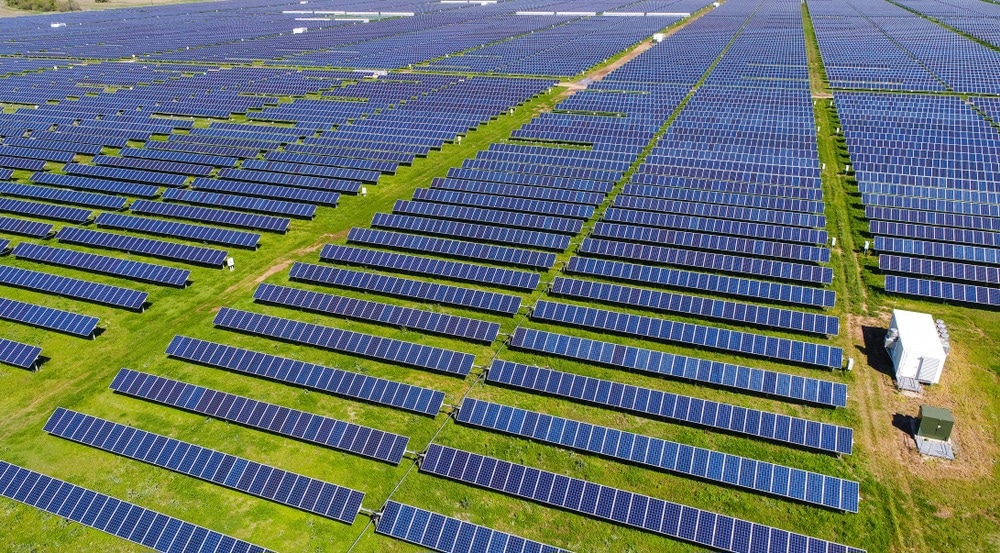Utilizing data from thermal imaging and weather instruments gathered by an unmanned aerial vehicle (UAV) is an innovative method for determining the power efficiency of an on-field solar photovoltaics (PV) system. This technique is intended for the non-intrusive, efficient, labor-saving, secure detection of the PV system's performance in a large-scale solar power plant.

Study: A Method for Estimating On-Field Photovoltaics System Efficiency Using Thermal Imaging and Weather Instrument Data and an Unmanned Aerial Vehicle. Image Credit: Roschetzky Photography/Shutterstock.com
A pre-proof study in Energies presents a drone equipped with a radiometer, temperature, and anemometer that can hover above PV modules with or without hotspots at a height of 1.5 m and a maximum lateral flight speed of 3.6 m/s. The researchers calculated the average temperatures of the PV modules using measured radiation intensity, ambient temperature, and wind speed.
Importance of Solar Energy
The production of energy on a worldwide scale depends on solar energy. Renewable energy production worldwide grew by 9.25% in 2022 compared to 2020.
Solar energy supplies 854 GW of all renewable energy. Three countries that produce the most solar energy globally are China (307 GW), the US (95 GW), and Japan (74 GW). The significance of solar energy cannot be overstated given the depletion of fossil fuels and climate change.
Parameters that Effect the Efficiency of Power Generation Using Solar Panels
Solar power generation efficiency is directly correlated with the volume of production. Industrial businesses install solar panels in large quantities to boost energy production. Unfortunately, dust and other pollutants (including garbage and bird droppings) adhere to the surfaces of solar panels over their lifetime. If the solar panel is not cleaned right away, solar energy cannot be converted into electrical energy. Instead, the solar energy is transformed into heat, which results in hotspots on the solar panel and lowers its capacity to produce energy.
Solar panels have a 25-year lifespan under ideal circumstances. Their lifetime energy output largely depends on how well they are maintained. It would be impractical to remove existing solar panels, transport them back to the manufacturer, and then study how well they generate electricity.
Limitations of Current Methods to Detect Hotspots on Solar Panels
Ultrasound, thermal, and electroluminescence (EL) imaging are used to examine solar panels.
EL imaging examines the light that PV cells emit when energy is applied. Engineers can examine the patterns of emitted light to assess the integrity of the silicon in PV cells because the emitted light directly correlates with the ion concentration in the PN junction of PV cells. The procedure takes a long time and requires a lot of manual work.
UAV with an IR Imager to Detect Hotspots on Solar Panels
UAVs equipped with IR imagers can be used to detect hotspots on solar panels. They can be divided into three categories. The first involves analyzing images using an artificial neural network and classification learning algorithms to locate the hotspots on a solar panel. The second involves estimating the efficiency while determining the surface temperature of solar panels using an IR image. The third involves using hotspots to locate solar panels using GPS coordinates and RGB imagery.
Development of On-Board IR Imaging on Drones for Real-Time Solar Panel Analysis
Chiang et al. devised an effective, non-intrusive testing method using onboard IR imaging on drones with additional sensors, such as wind speed meters, to perform a real-time solar panel inspection of a solar power plant. The researchers put forward the method of determining the temperature of the modules using the instantly collected meteorological data.
Based on the data reported in this study, the module efficiency can be measured by correlating the module efficiency with the estimated temperature for various solar panels. The experiments provide a further approach for real-time study of solar panel efficiency by conducting an initial investigation of solar panels using IR imaging and establishing a relationship between power efficiency, temperature, and hotspots using regression.
Research Findings
Large-surface area solar power systems are challenging to examine and maintain. Solar panels need to be removed for efficiency measurements, which takes time and manual labor.
This research uses a combination of UAVs, thermal imagers, and weather stations to create a compelling and accurate technique for assessing deteriorated solar panels with hotspots. The study calculates the efficiency by examining the effects of solar panel temperatures and hotspot density.
According to this study, hotspots significantly reduce the power output of solar panels. The researchers examined 16 PV modules utilizing a UAV and a thermal imager to examine the relationship between the number of hotspots and the remaining efficiency of a solar panel.
Onboard IR imaging on drones with thermal sensors is a technique for efficiently estimating a degraded solar panel’s remaining efficiency by contrasting its performance with the temperature of a brand-new solar panel using information from weather stations. A total of 16 solar panels were examined, and the measurement errors were between 2% and 5%. The novel strategy created in this study can significantly increase the effectiveness of power plant operations while also saving money and time.
Reference
Chiang, W.-H., Wu, H.-S., Wu, J.-S., & Lin, S.-J. (2022). A Method for Estimating On-Field Photovoltaics System Efficiency Using Thermal Imaging and Weather Instrument Data and an Unmanned Aerial Vehicle. Energies, 15(16), 5835. https://www.mdpi.com/1996-1073/15/16/5835
Disclaimer: The views expressed here are those of the author expressed in their private capacity and do not necessarily represent the views of AZoM.com Limited T/A AZoNetwork the owner and operator of this website. This disclaimer forms part of the Terms and conditions of use of this website.